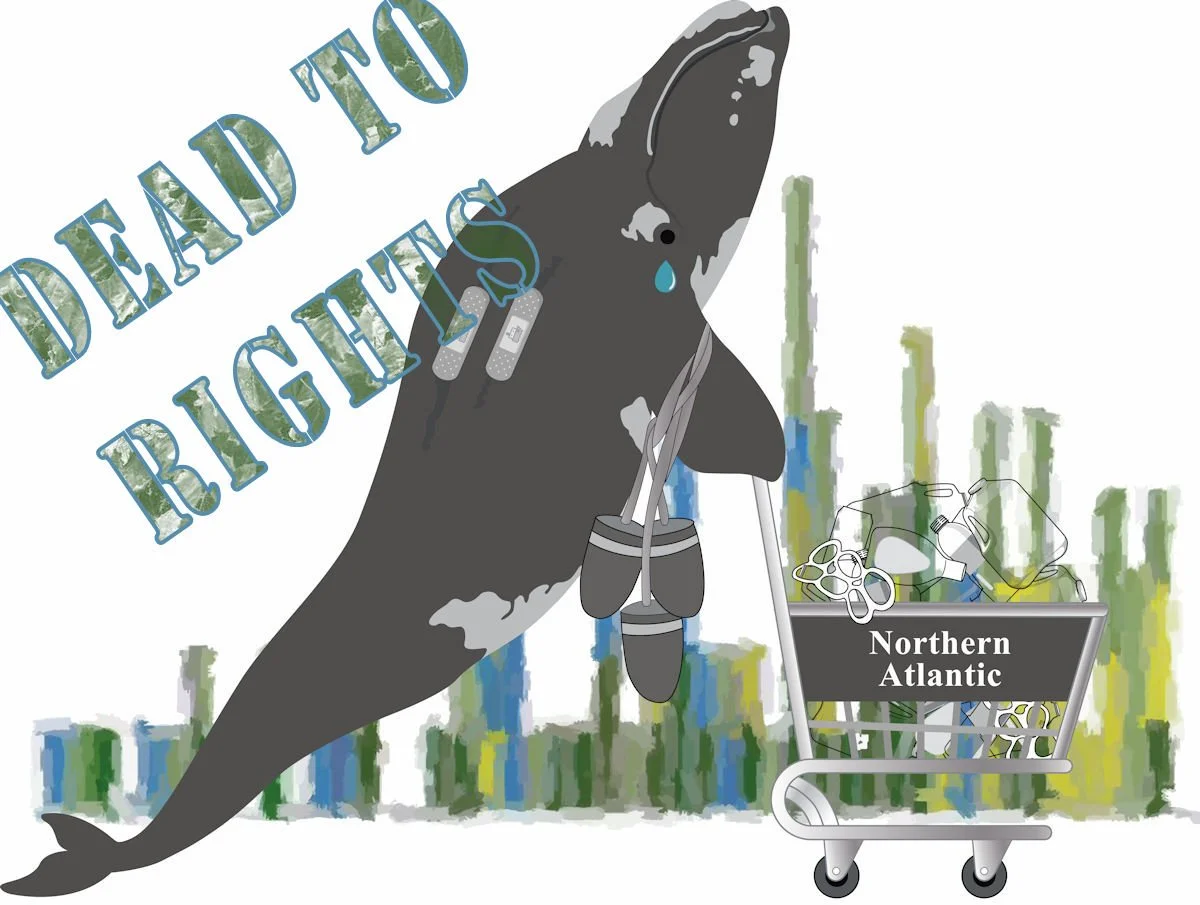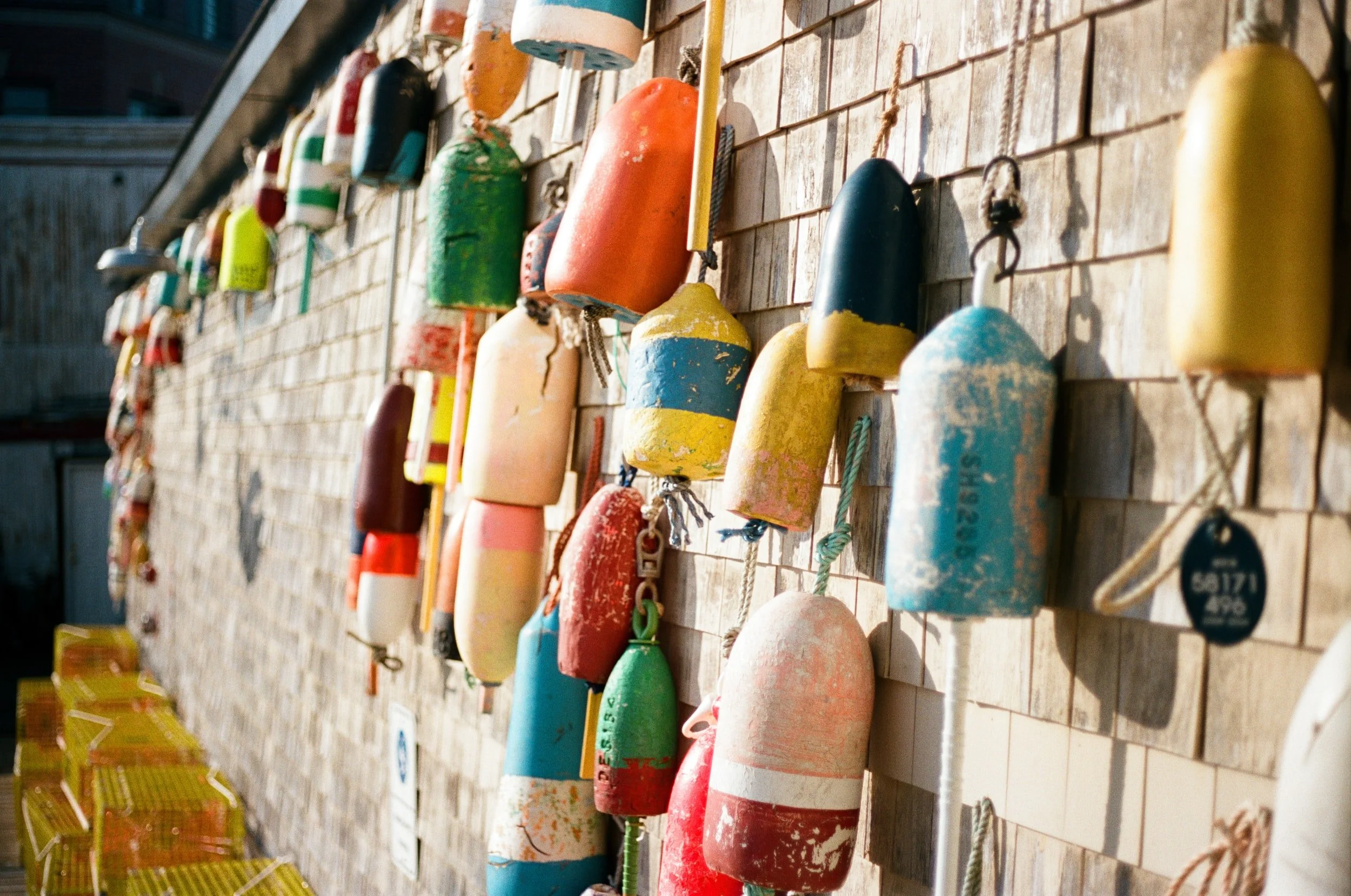Are North Atlantic right whales destined for extinction?
Dead to Rights © by Pam Ferris-Olson
Once hunted, now protected, extremely endangered
North Atlantic right whales are big. They are nearly as hefty as a blue whale, the largest animal to have ever lived and that includes dinosaurs. An adult can weigh nearly 70 tons. Right whales measure approximately 45- to 55-ft. in length.
In the era when whales were regularly hunted, right whales were valued for the oil that was rendered from their blubber or fat. The whale’s oil was burned as fuel for lamps. It also was used to make soap. The baleen or bristles in the whale’s mouth were used in the construction of umbrellas and women’s corsets. In the whale, baleen acts as a filter, providing a way for them to separate the tiny plankton they eat from sea water.
As commercial whaling adopted new technologies such as gun-loaded harpoons and steam powered ships, commercial fishing became more deadly. According to National Geographic, whaling was a multi-million dollar industry and by the early 1900s more whales were being killed than in the previous four centuries combined. It wasn’t until 1971 that the U.S. officially outlawed whaling. At that time it is estimated that as few as 100 right whales remained. Because of their depleted numbers, right whales were listed as endangered and protected by a variety of laws including the Endangered Species Act and the Marine Mammal Protection Act. Since 2011, however, the North Atlantic right whale population has been on a downward trajectory.
“There is no question that human activities are driving this species toward extinction. There is also no question that North Atlantic right whales are an incredibly resilient species. No one engaged in right whale work believes that the species cannot recover from this. They absolutely can, if we stop killing them and allow them to allocate energy to finding food, mates, and habitats that aren’t marred with deadly obstacles” said Dr. Scott Kraus, chair of the North Atlantic Right Whale Consortium.
Are humans still killing right whales?
The simplest answer to the question is YES. The killing in recent years has been unintentional but it is nonetheless devastating. The main causes of death are:
●strikes by vessels in areas of active shipping
●entanglements in fishing gear.
In 2011, the North Atlantic right whale population was estimated to be 481 animals. In the last decade that number has declined by 30 percent. In an October 25, 2021 publication by the New England Aquarium, research was said to reveal that 86 percent of known right whales had scars caused by entanglement in fishing gear. Additionally, the research showed that right whale body lengths have declined during the last 40 years suggesting that the entanglements cause stress in the whales that resulted in reduced amounts of energy for growth and reproduction. In 2019, the North Atlantic Right Whale Consortium estimated that the right whale population numbered 366 but a year later that number had dropped to 336, an 8 percent decrease.
Different places, different management perspectives
North Atlantic right whales live along the east coast of the U.S. and Canada. It might not be surprising to learn that the two countries manage the whales differently but it might be unexpected to discover that in the US the northern and southern states, exemplified by a comparison between Maine to the north and Georgia in the south, don’t share the same perspectives.
Maine: the lobster fishing industry versus conservationists
The lobster fishing industry and conservation organizations are at odds when it comes to their view of making rules to protect the survival of the North Atlantic right whales. Their dispute has landed them in the courtroom. Here’s a brief look at these competing interests.
The lobster fishing industry
As a $1.4 billion industry, lobster is important to Maine’s economy. The industry has been lobbying hard against plans by federal agencies to establish a management plan for the whales. A protection plan for the whales is required under the Endangered Species Act. The plan was developed after years of research and public input. The rules issued in 2021 by the National Oceanic and Atmospheric Administration bar the traditional rope-and-buoy lobster method in designated areas during the months of October through January.
Virginia Olsen of the Maine Lobstering Union in association with other industry advocates criticized the statistical modeling used federal agencies to create the plan for a seasonal lobster ban. In rope-and-buoy lobster fishing, buoys are used to mark the underwater location of lobster traps. The problem is that the rope that connects the buoy to the trap can ensnare whales resulting in physical harm and even death. Olsen argues that more evidence is needed to prove that right whales actually spend time in the areas that are to be closed to the rope-and-buoy ban. She contends that right whales are found further offshore, beyond the closed area, and that no hard data exists to link Maine lobster gear with killing right whales. Fishing groups with support by Maine’s U.S. Senators Susan Collins and Angus King, U.S. Representives Chellie Pingree and Jared Golden, and Governor Janet Mills also contend that the financial costs of the ban are too high. They say the ban will financially impact as many as 200 boats and that they may lose as much as half their annual earnings. These boats make top-dollar because they fish offshore during months when the lobster caught is reduced and the holiday demand is high.
Environmental advocates like the Conservation Law Foundation counter these arguments by noting the ban comes at a particularly critical time for the future survival of the North Atlantic right whale. Since 2017, the National Oceanic and Atmospheric Administration has documented 9 North Atlantic right whale deaths and another 14 injuries due to entanglement. An additional 11 have died after being struck by vessels. In the last 4 years, 50 deaths have occurred, a devastating number in a severally depleted population.
Erica Fuller, an attorney with the Conservation Law Foundation, says that every right whale death matters. “We’re confident that the agency made an evidence-based and reasoned decision when it closed this area … to reduce entanglement risks. These critically endangered right whales need the immediate protections of this (closure) – they don’t have years to wait.”
The financial cost estimates of the seasonal ban given by the government agencies differ from the lobster industry. The government estimates 62 boats would be displaced by the seasonal ban and an equal number of boats fishing in the area adjacent to the closed area might suffer direct competition when they have to share the same fishing grounds with the displaced boats. Furthermore, their estimate for loss in lobster boat earnings is less, around 5-10 percent.
Georgia: A prized marine mammal
Georgia, unlike Maine, has designated a state marine mammal and it’s the North Atlantic right whale. Residents in Georgia feel protective of the right whales that visit their coast during the months of November to March. “Our waters provide safe and warm habitat to have their babies and gain their strength for the long expedition home to the North Atlantic and Canadian waters in the Spring. We are very lucky to play such an important role in the future of one of the planets most endangered large marine mammals roaming the seas,” wrote Hermina Glass-Hill, executive director of Georgia’s Susie King Taylor Women’s Institute and Ecology Center.
The calving grounds for the North Atlantic right whale stretch from Jacksonville, Florida, along the entire coast of Georgia, and into South Carolina. Biologists use aerial surveys to monitor calving behavior and implemented an educational program targeting commercial shipping ports and military installations to help reduce the devastating incidence of vessel strikes with the whales. According to Glass-Hill the loss of one or two female right whales a year could lead to extinction of the species within a century.
“It was heart wrenching to watch images of the injured baby right whale off the Georgia coast last month. To know that the injuries were caused by boat strike is terribly alarming. Boaters, whether recreational or fishing, should be more conscientious of calving season and do their part to protect this endangered species of whales,” bemoaned Glass-Hill.
To make Georgian’s more aware about their state marine mammal, the first annual Whale Week was held in Savannah in 2018. The grassroots effort was started by Paulita Bennett-Martin. She felt it was important to disseminate information about the North Atlantic right whale because she’d “talked to friends that had no idea we have these whales right here off the coast.”
Canada: warming seas, changing food patterns
The warming waters off the coast of Maine are driving right whales northward in the search for food. Until 2010, the whales traveled, calves in tow, northward into Canadian waters during the summer. The whales followed copepods, tiny crustaceans. The whales use their baleen to filter the tiny creatures from the water they scoop into their mouths. According to Oceana Canada, since 2010 as the Gulf of Maine and the Bay of Fundy warmed, a result of climate change, the whales have been spending more time feeding in the Gulf of St. Lawrence. This migration has led the whales into an area with an increased risk for entanglements in fishing gear and vessel strikes in the busy shipping area. Oceana Canada noted in a blog that since 2017 at least 34 right whales have been killed and an additional 16 right whales suffered serious injuries. During the years, 2017 and 2019, there were a total of 21 right whale deaths in Canadian waters.
Is there hope for the survival of the North Atlantic right whale?
Here’s what is known:
● There are factors that negatively impact the whales that humans have little or no control over, foremost among these is climate change.
● A coordinated and immediate action along the entire whale’s range is needed to eliminate entanglements in fishing gear and strikes by vessels.
● With a rapidly declining population, there is precious little time to act. There is insufficient time, as the Maine lobster industry demands, for PROOF that right whales occupy the areas designated to be closed from October to January or that Maine’s rope-and-buoy fishing entangles the whales.
● The survival potential will not be determined by the total number of whales. What is required is that there are males and females capable of breeding and in numbers large enough for them to find mates, and there is adequate protection to assure calves will grow and thrive so they too are able to breed and produce new offspring.
● If these things are not possible, it is unlikely that the North Atlantic right whale will survive to the next century.
● Extinction is forever.
North Atlantic right whales may be on the brink of extinction, but there is still hope but we must continue to advocate for action on their behalf.






